Mechanistic Investigation of Typical Loess Landslide Disasters in Ili Basin, Xinjiang, China
Abstract
:1. Introduction
2. Geological Conditions of the Study Area and Research Methods
2.1. Geological Conditions
2.2. Methods
3. Case Study of Typical Geological Disasters in the Study Area and their Disaster Modes
3.1. Piliqinghe Landslide
- (1)
- Erosion and collapse of the leading edge. In the spring, the snowmelt increased the flow rate of the Piliqinghe River. As a result, the lateral erosion was intensified, and the bank slope was undercut, forming a free face. Therefore, the leading edge of the landslide was partially unbalanced, and multiple sliding collapses occurred, as can be observed in the multi-period remote sensing images.
- (2)
- Creep sliding and tension cracking of the surface. As the snowmelt infiltrated into the slope, the variation in the diurnal temperature around 0 °C led to intense freeze–thaw cycles, which reduced the mechanical strength of the soil, resulting in the formation of cracks on the landslide surface. Meanwhile, as the water content of the soil increased, shear creep occurred on the slope surface, causing creep tension cracking under gravity. Hence, the cracks in the slope were widened, and continuous tensile cracks occurred at the trailing edge.
- (3)
- Overall deformation and sliding. As the freeze–thaw cycles continued, the frost heave effect further increased the cracks at the trailing edge of the landslide. With the infiltration of a large amount of snowmelt along the cracks, the water content rose sharply, and the soil became nearly saturated. As a result, the friction decreased dramatically, disrupting the original force balance of the loess structure. Consequently, the landslide slid down at high speed, rushing into and burying the fishpond and blocking the Piliqinghe River to form a barrier lake.
3.2. Numerical Simulation of the Landslide
4. Conclusions
- (1)
- The disaster process of the No. 2 Piliqinghe landslide was as follows: fluvial scouring of the slope toe leading to the local sliding of the leading edge → snowmelt infiltration resulting in the creep sliding and tension cracking of the slope surface → overall sliding of the slope.
- (2)
- The infiltration of snowmelt due to temperature increase was the direct cause of landslide formation. The infiltrated snowmelt was transformed into groundwater, which saturated the loess and increased the pore water pressure, thereby decreasing the slope stability factor and leading to an overall sliding under gravity.
- (3)
- The stability and the underlying deformation and failure mechanism of the No. 2 Piliqinghe landslide were investigated using the finite difference strength reduction method. The results showed the following. In the dry season, the slope had a stability factor of 1.254, indicating that it was stable. The shear strain at the front of the slope was large, with a maximum value of 3.59 × 10−4, and the maximum displacement in the slope was 0.304 m. In the rainy season, the slope was in the limit equilibrium state, and the stability factor was calculated to be 0.985. The plastic shear strain, which had a maximum value of 9.29 × 10−4, was distributed along the sliding zone, and the trailing edge of the landslide was consistent with the crack position in the upper part of the slope. The maximum displacement in the slope was 0.636 m. Therefore, regarding the prevention of loess landslide disasters in the Ili region, the results suggest that cracks in the trailing edge of the slope have an extremely important influence on the landslide and that additionally, instability in the middle and back parts of the landslide has a strong impact on the stability of the whole slope and should be avoided. These findings can be used as a reference for the analysis of the disaster mechanism and movement characteristics of similar loess landslides and provide further theoretical support for disaster prevention and mitigation.
Author Contributions
Funding
Data Availability Statement
Acknowledgments
Conflicts of Interest
References
- Liu, D. Loess and Environment; Science Press: Beijing, China, 1985. [Google Scholar]
- Ishihara, K.; Okusa, S.; Oyagi, N.; Ischuk, A. Liquefaction-induced flow slide in the collapsible loess deposit in Soviet Tajik. Soils Found. 1990, 30, 73–89. [Google Scholar] [CrossRef] [Green Version]
- Havenith, H.-B.; Torgoev, A.; Schlögel, R.; Braun, A.; Torgoev, I.; Ischuk, A. Tien Shan geohazards database: Landslide susceptibility analysis. Geomorphology 2015, 249, 32–43. [Google Scholar] [CrossRef]
- Cui, Y.; Xu, C.; Xu, S.; Chai, S.; Fu, G.; Bao, P. Small-scale catastrophic landslides in loess areas of China: An example of the March 15, 2019, Zaoling landslide in Shanxi Province. Landslides 2020, 17, 669–676. [Google Scholar] [CrossRef]
- Xu, C.; Xu, X.; Shyu, J.B.H.; Zheng, W.; Min, W. Landslides triggered by the 22 July 2013 Minxian–Zhangxian, China, Mw 5.9 earthquake: Inventory compiling and spatial distribution analysis. J. Asian Earth Sci. 2014, 92, 125–142. [Google Scholar] [CrossRef]
- Zhou, J.-X.; Zhu, C.-Y.; Zheng, J.-M.; Wang, X.-H.; Liu, Z.-H. Landslide disaster in the loess area of China. J. For. Res. 2002, 13, 157–161. [Google Scholar]
- Derbyshire, E.; Jingtai, W.; Zexian, J. In the Gansu Loess of China. Catena Suppl. 1991, 20, 119–145. [Google Scholar]
- Tu, X.; Kwong, A.; Dai, F.; Tham, L.; Min, H. Field monitoring of rainfall infiltration in a loess slope and analysis of failure mechanism of rainfall-induced landslides. Eng. Geol. 2009, 105, 134–150. [Google Scholar] [CrossRef]
- Peng, J.; Wang, G.; Wang, Q.; Zhang, F. Shear wave velocity imaging of landslide debris deposited on an erodible bed and possible movement mechanism for a loess landslide in Jingyang, Xi’an, China. Landslides 2017, 14, 1503–1512. [Google Scholar] [CrossRef]
- Fan, X.; Xu, Q.; Scaringi, G.; Li, S.; Peng, D. A chemo-mechanical insight into the failure mechanism of frequently occurred landslides in the Loess Plateau, Gansu Province, China. Eng. Geol. 2017, 228, 337–345. [Google Scholar] [CrossRef]
- Jin, Y.-L.; Dai, F.-C. The mechanism of irrigation-induced landslides of loess. Yantu Gongcheng Xuebao (Chin. J. Geotech. Eng.) 2007, 29, 1493–1499. [Google Scholar]
- Wang, Z.R.; Wu, W.; Zhou, Z.Q. Landslide induced by over-irrigation in loess platform areas in Gansu Province. The Chinese J. Geol. Hazard Control 2004, 15, 43–46. [Google Scholar]
- Close, U. Where the nountains walked. Natl. Geogr. Mag. 1922, 41, 445–464. [Google Scholar]
- Derbyshire, E.; Dijkstra, T.; Smalley, I.; Li, Y. Failure mechanisms in loess and the effects of moisture content changes on remoulded strength. Quat. Int. 1994, 24, 5–15. [Google Scholar] [CrossRef]
- Wang, J.; Liu, W.; Chen, W.; Liu, P.; Jia, B.; Xu, H.; Wen, L. Study on the mechanism of loess landslide induced by chlorine salt in Heifangtai terran. Jpn. Geotech. Soc. Spec. Publ. 2019, 7, 159–167. [Google Scholar] [CrossRef]
- Xu, L.; Coop, M.R.; Zhang, M.; Wang, G. The mechanics of a saturated silty loess and implications for landslides. Eng. Geol. 2018, 236, 29–42. [Google Scholar] [CrossRef]
- Zhang, F.; Wang, G. Effect of irrigation-induced densification on the post-failure behavior of loess flowslides occurring on the Heifangtai area, Gansu, China. Eng. Geol. 2018, 236, 111–118. [Google Scholar] [CrossRef]
- Lei, X. Geo-Hazards in Loess Plateau and Human Activity; Science Press: Beijing, China, 2001. [Google Scholar]
- Guangtao, H. Landslide Dynamics; Geological Publishing House: Beijing, China, 1995. [Google Scholar]
- Guorui, G. Formation and development of the structure of collapsing loess in China. Eng. Geol. 1988, 25, 235–245. [Google Scholar] [CrossRef]
- Zhou, Y.; Tham, L.; Yan, W.; Dai, F.; Xu, L. Laboratory study on soil behavior in loess slope subjected to infiltration. Eng. Geol. 2014, 183, 31–38. [Google Scholar] [CrossRef]
- Wu, W.; Wang, N. Lanslides in Gansu Province; Lanzhou University Press: Lanzhou, China, 2006. [Google Scholar]
- Zhang, M.-S.; Liu, J. Controlling factors of loess landslides in western China. Environ. Earth Sci. 2010, 59, 1671–1680. [Google Scholar] [CrossRef]
- Maosheng, Z.; Tonglu, L. Triggering factors and forming mechanism of loess landslides. J. Eng. Geol. 2011, 19, 530–540. [Google Scholar]
- Ge, S.; McKenzie, J.; Voss, C.; Wu, Q. Exchange of groundwater and surface-water mediated by permafrost response to seasonal and long term air temperature variation. Geophys. Res. Lett. 2011, 38, 14. [Google Scholar] [CrossRef] [Green Version]
- McKenzie, J.M.; Voss, C.I.; Siegel, D.I. Groundwater flow with energy transport and water–ice phase change: Numerical simulations, benchmarks, and application to freezing in peat bogs. Adv. Water Resour. 2007, 30, 966–983. [Google Scholar] [CrossRef]
- Xiong, H.; Liu, G.; Cui, Z. The characteristics and vertical zone spectrum of natural disasters in the Tianshan Mountains, Xinjiang. Chin. Geogr. Sci. 1999, 9, 126–133. [Google Scholar] [CrossRef]
- Li’nan, L.; Shouding, L.; Yue, J.; Yaheng, B.; Yu, L. Failure mechanism of loess landslides due to saturated-unsaturated seepage-case study of Gallente landslide in Ili, Xinjiang. J. Eng. Geol. 2017, 25, 1230–1237. [Google Scholar]
- Yang, L.; Wei, Y.; Zhu, S. Formation mechanism of the Kezilesai Landslide in Yining County, Xinjiang and its dynamic characteristics. Chin. J. Geol. Hazard Control 2018, 29, 18–24. [Google Scholar]
- Wang, W.; Yin, Y.; Zhu, S.; Wei, Y.; Zhang, N.; Yan, J. Dynamic analysis of a long-runout, flow-like landslide at Areletuobie, Yili River valley, northwestern China. Bull. Eng. Geol. Environ. 2019, 78, 3143–3157. [Google Scholar] [CrossRef]
- Zhuang, M.; Wei, Y.; Shao, H.; Zhu, S. Type and characteristics of loess landslides in Piliqing River. Yili of Xinjiang Uygur autonomous region. Chin. J. Geol. Hazard Control 2018, 29, 54–59. [Google Scholar]
- Zhu, S.; Yin, Y.; Wang, W.; Wei, Y. Mechanism of Freeze-thaw Loess Landslide in Yili River Valley, Xinjiang. Acta Geosci. Sin. 2019, 40, 339–349. [Google Scholar]
- An, H.; Liu, P. Genesis and influencing factors of loess landslides in Yili region in Xinjiang. J. Geol. Hazards Environ. Preserv. 2010, 21, 22–25. [Google Scholar]
- Chen, P. Causal Analysis and Stability Evaluation of Loess Landslide in Yili Region of Xinjiang–A Case Study of Alar Village Landslide, Recent Research on Engineering Geology and Geological Engineering. In Proceedings of the 2nd GeoMEast International Congress and Exhibition on Sustainable Civil Infrastructures, Egypt 2018—The Official International Congress of the Soil-Structure Interaction Group in Egypt (SSIGE), Giza, Egypt, 24–28 November 2018; Springer: Berlin/Heidelberg, Germany, 2018; p. 94. [Google Scholar]

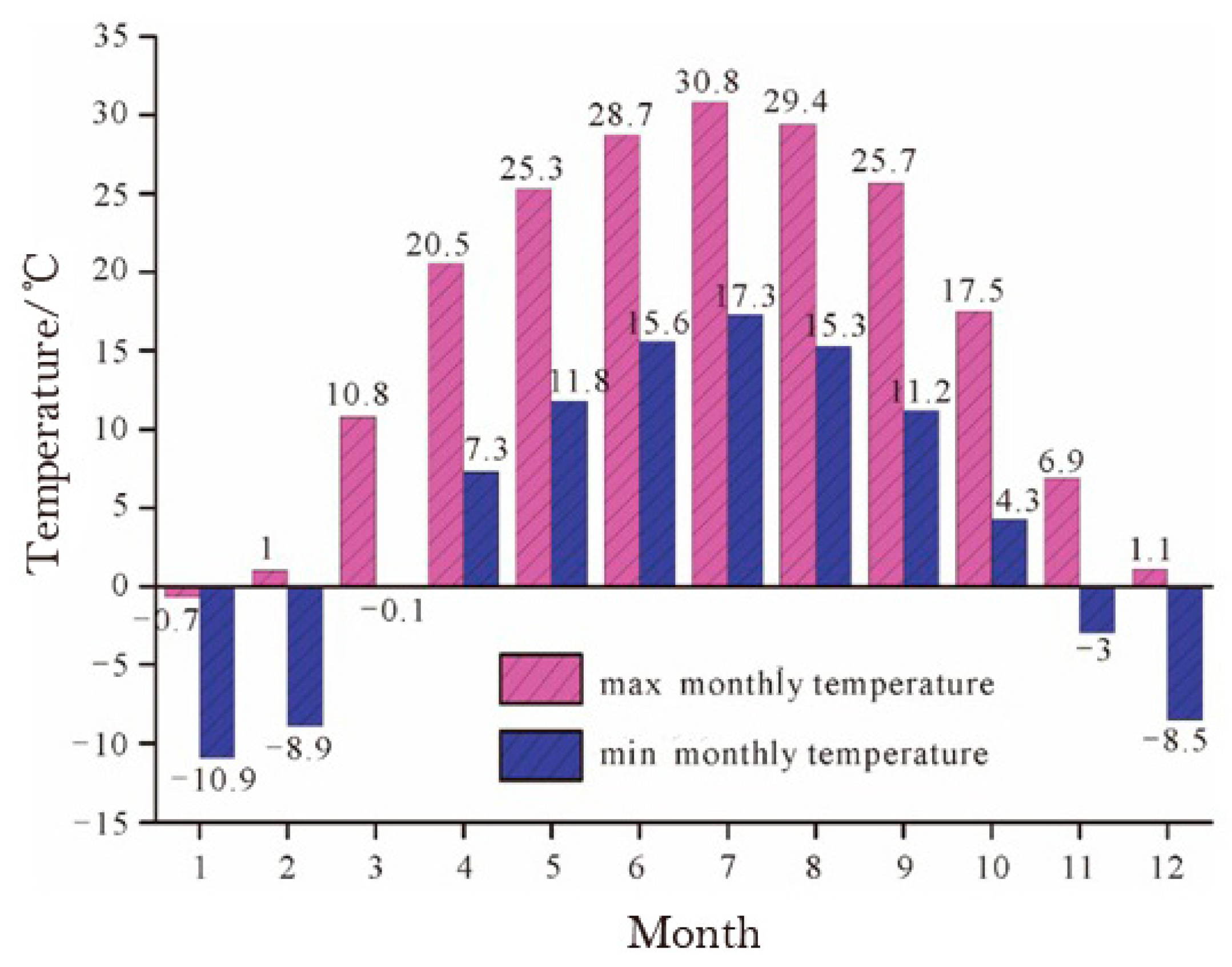
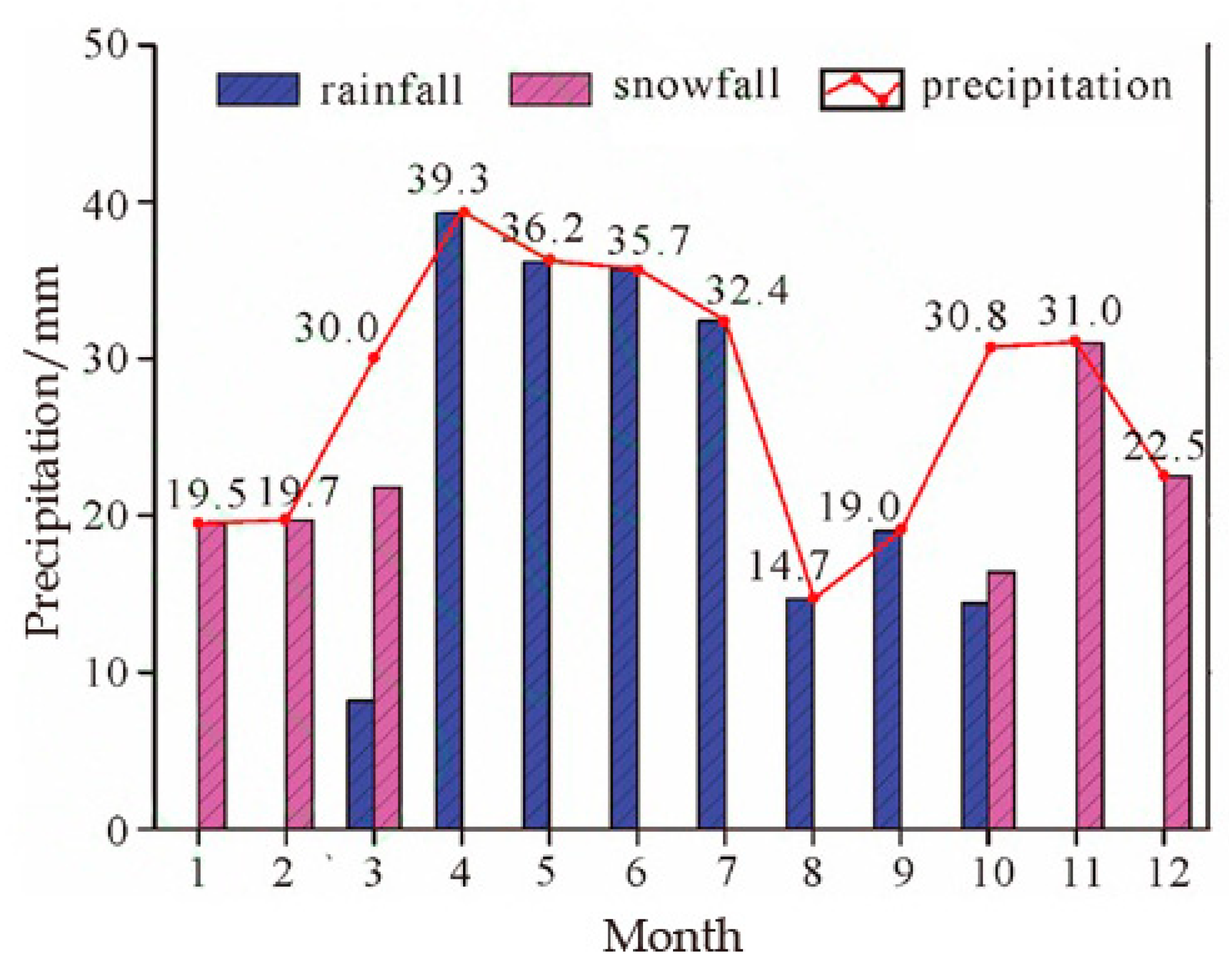

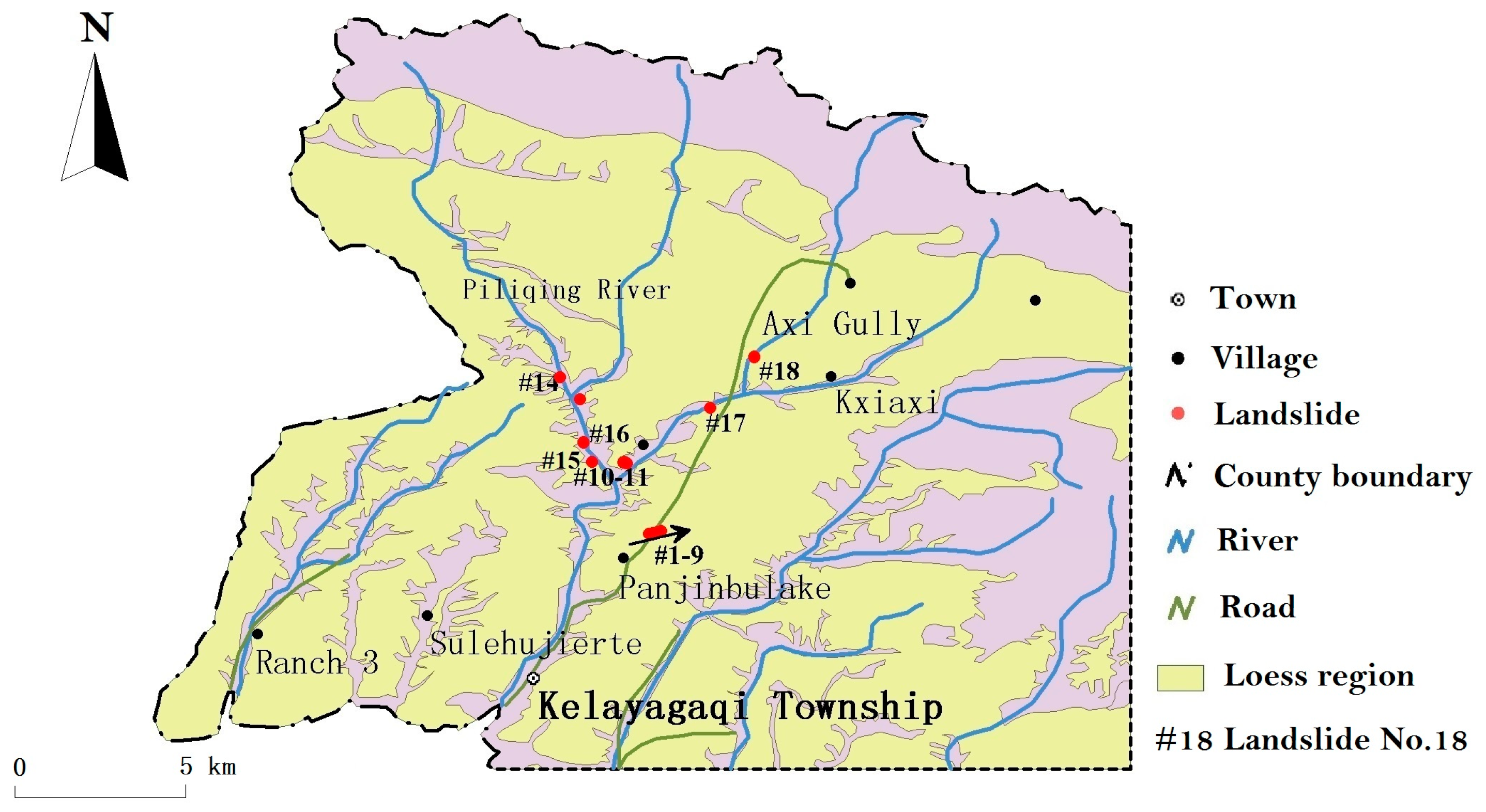




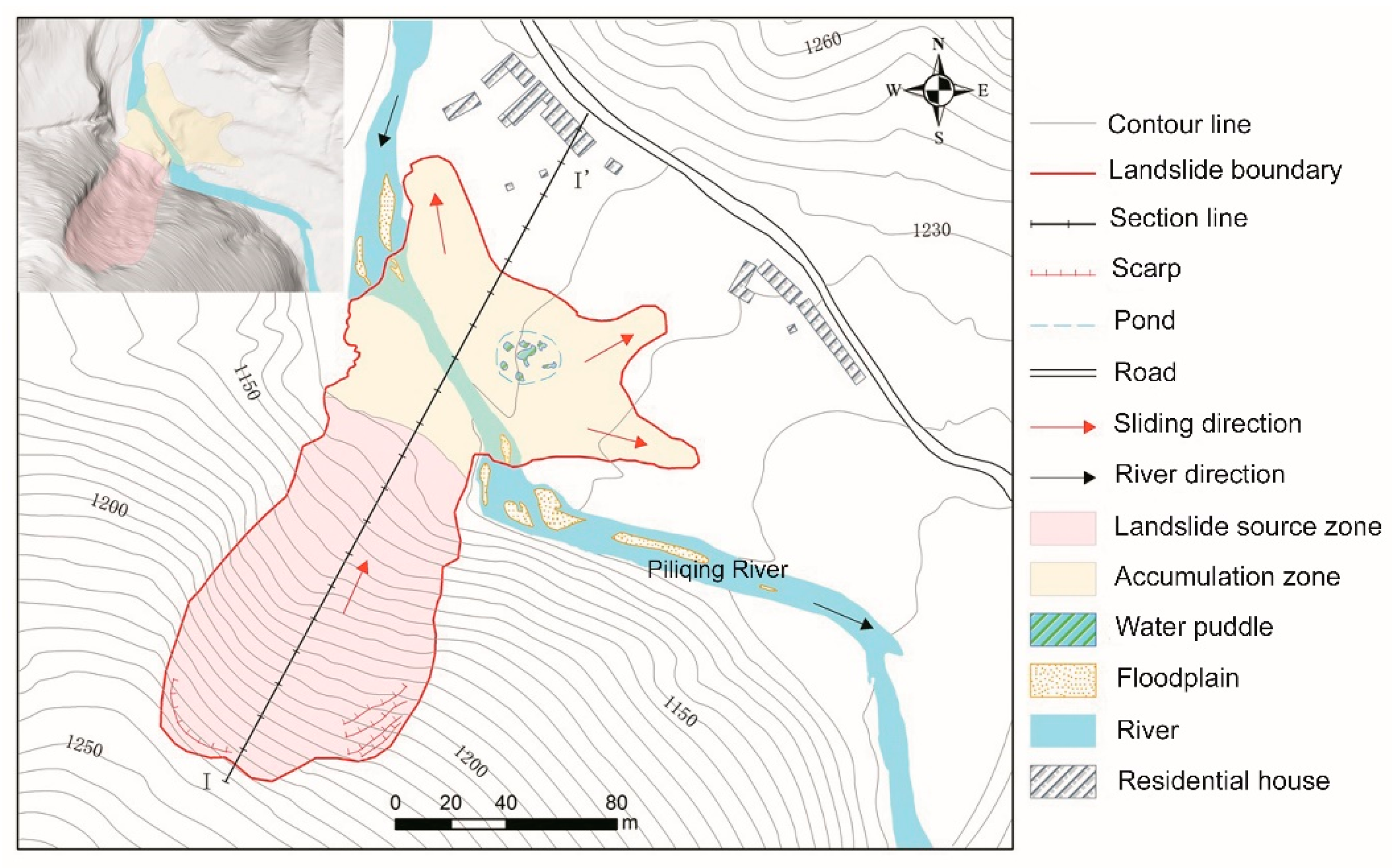



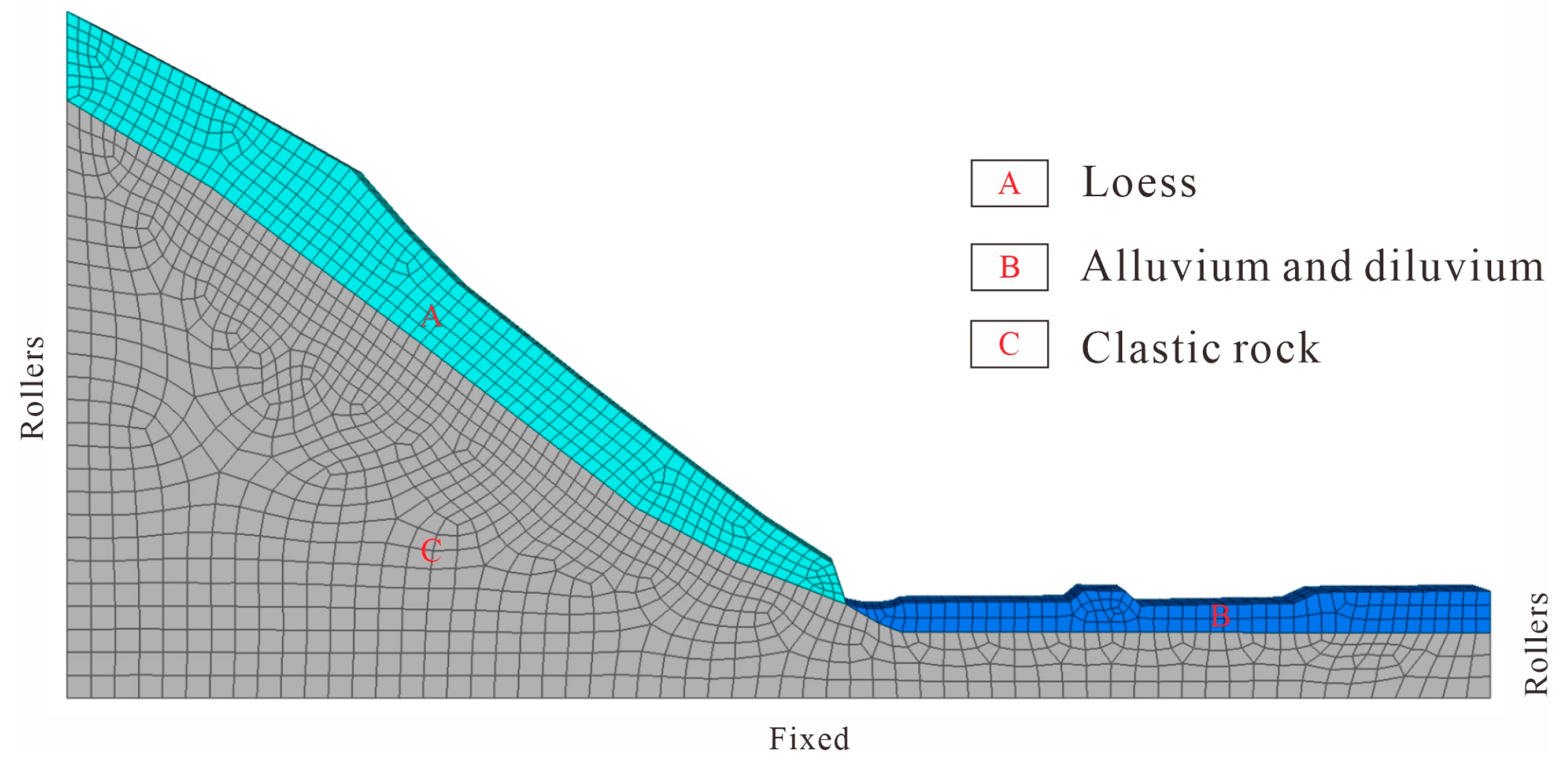

| Year | Total Number in Xinjiang | Ili | ||||
|---|---|---|---|---|---|---|
| Total Number | Spring (March to May) | Summer (June to August) | Autumn (September to November) | Winter (December to next February) | ||
| 2010 | 68 | 31 | 31 | |||
| 2011 | 11 | 6 | 3 | 1 | 2 | |
| 2012 | 40 | 6 | 4 | 1 | 1 | |
| 2013 | 29 | 6 | 1 | 5 | ||
| 2014 | 15 | 2 | 2 | |||
| 2015 | 13 | 4 | 2 | 2 | ||
| 2016 | 65 | 35 | 17 | 18 | ||
| 2017 | 61 | 40 | 29 | 11 | ||
| 2018 | 28 | 6 | 3 | 2 | 1 | |
| Sum | 330 | 136 | 92 | 40 | 4 | |
| Material Type | Name of Material | Density γ/g∗m−3 | Elastic Modulus E/GPa | Poisson’s Ratio v | Tensile Strength t/KPa | Cohesion c/KPa | Internal Friction Angle φ/° |
|---|---|---|---|---|---|---|---|
| A | Loess | 1670 (1930) | 0.043 (0.021) | 0.30 (0.32) | 15.72 (13.44) | 17.78 (14.32) | 23.30 (20.08) |
| B | Alluvium & diluvium | 2100 | 0.042 | 0.32 | 13.00 | 13.38 | 21.47 |
| C | Clastic rock | 2542 | 30 | 0.28 | 113.65 | 120 | 45 |
Publisher’s Note: MDPI stays neutral with regard to jurisdictional claims in published maps and institutional affiliations. |
© 2021 by the authors. Licensee MDPI, Basel, Switzerland. This article is an open access article distributed under the terms and conditions of the Creative Commons Attribution (CC BY) license (http://creativecommons.org/licenses/by/4.0/).
Share and Cite
Zhuang, M.; Gao, W.; Zhao, T.; Hu, R.; Wei, Y.; Shao, H.; Zhu, S. Mechanistic Investigation of Typical Loess Landslide Disasters in Ili Basin, Xinjiang, China. Sustainability 2021, 13, 635. https://doi.org/10.3390/su13020635
Zhuang M, Gao W, Zhao T, Hu R, Wei Y, Shao H, Zhu S. Mechanistic Investigation of Typical Loess Landslide Disasters in Ili Basin, Xinjiang, China. Sustainability. 2021; 13(2):635. https://doi.org/10.3390/su13020635
Chicago/Turabian StyleZhuang, Maoguo, Wenwei Gao, Tianjie Zhao, Ruilin Hu, Yunjie Wei, Hai Shao, and Sainan Zhu. 2021. "Mechanistic Investigation of Typical Loess Landslide Disasters in Ili Basin, Xinjiang, China" Sustainability 13, no. 2: 635. https://doi.org/10.3390/su13020635





